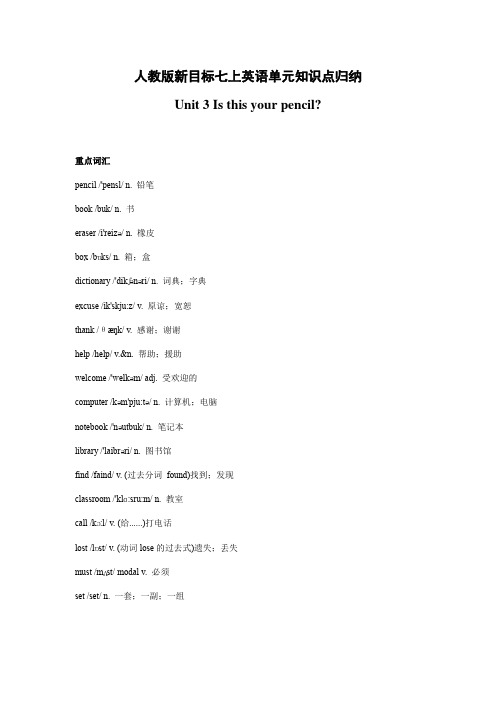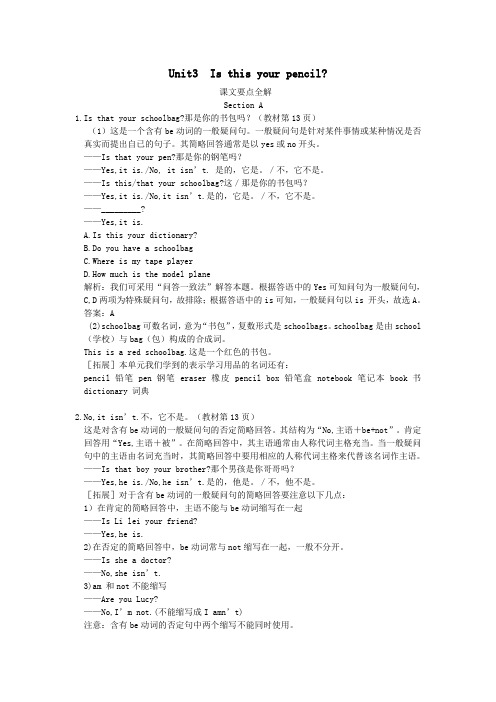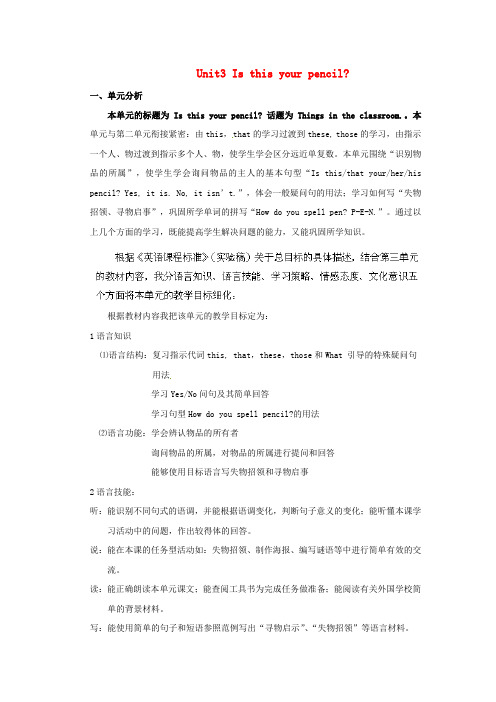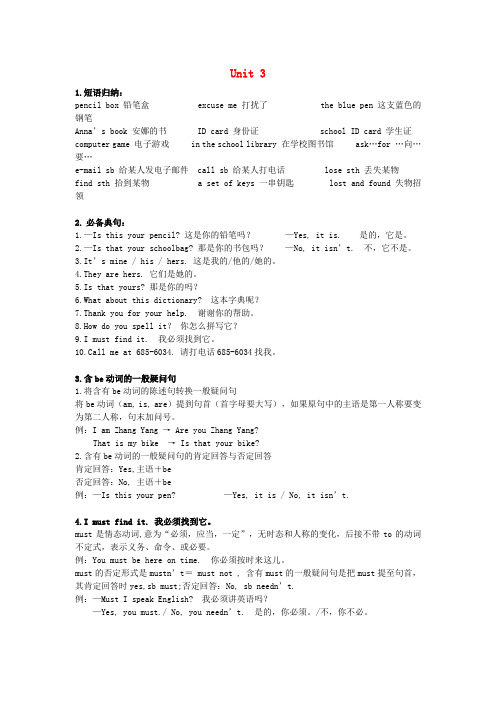新版人教新目标 初一上册Unit 3 Is this your pencil
人教新目标版七年级英语上册Unit3Isthisyourpencil?教案(1)

Unit 3 Is this your pencil?Ⅰ.Teachin g AimsKnowledge ObjectsKey vocabulary: pencil, pen, book, eraser, ruler, pencil box, schoolbag,dictionaryTarget language: Is this your pencil?Yes, it is. I t’s mine.Is that your backpack?No, it isn’t. It’s his.Are these your books?No, they aren’t. They’re hers.Ability ObjectsTrain students’ listening skill.Train students’ communicative competence using key vocabulary and target language.Moral ObjectIf something doesn’t belong to you, give it back to its owner.Ⅱ.Key PointsThe names of some common personal possessions.How to identify ownership.Ⅲ.Difficult PointStudents can communicate wit h others using the key vocabulary and the target language learned in this class in everyday situations.Ⅳ.Teaching Method sScene teaching method.Singing method.PairworkⅤ.Teaching AidsMultimediaⅥ.Teaching Procedures.Step1 RevisionListen to a song “Hi, hello, what’s your name?”Students listen to the song and try to sing it, and then answer with “my name is…”Point at a boy who has said his name and ask other students “What’s his name?” The other students may use “His name is…” to answer.Point at a girl and ask the students “What’s her name?” Students may use “Her name is…” to answer.Step2 Lead-inShow a pencil, ask students “What’s its name?”——“Pencil”“Is this your pencil?” …Step3 New words learningAsk the students “Where do you put your pencil in?” students must think about “pencil box”. Then learn this word.Ask students to take out the things in their pencil box. Learn the words: pen, eraser, ruler.“Where do you put your pencil box in?” Lead to the learning of “schoolbag”.“What are the other things in you schoolbag except the pencil box?” This sentence will lead to the learning of “book”, “dictionary”.Read the words for several times. Pay attention to the pronunciations.Give each pair of students an object. Ask them to make conversations using the words they have learned just now.(What’s this/that/these?---This is/That is/These are… Match the words with the things in the picture, and then check the answers (e g b h c f a d )Listen to a song “show me”.Get the students to sing the song and show their things.Step54Practice the target language.Show several pictures and ask the students to make conversations according to the pictures by themselves. Support following target language:Is this your … ? ——Yes, it is. It’s mine.——No, it isn’t. It’s his/hers.Is that your… ? ——Yes, it is. It’s mine.——No, it isn’t, It’s his/hers.Are these your… ?——Yes, they’re mine——No, they aren’t. They’rehis/hers.Read the conversations. Girls ask and boys answer.Step6 listeningListen to the conversations carefully.Listen to the conversations again, and number the conversations.Check the answers (3.2.1.)Listen for the third time and repeat the conversations.Teaching aims学完本课后,学生应能:学生应能掌握关于文具用品的单词(听和写)。
【快乐背单词】英语人教版七年级上册 Unit3_Is_this_your_pencil?

Unit 3 Is this your pencil?1. pencil 铅笔拼音法:pen喷+词ci+了l 铅笔竟然自己会喷词了。
拼音法:pen碰(peng)+瓷ci+了l 铅笔来碰瓷了!2. book 书拼音法:b不o哦ok可以客官不可以哦,你得看书!3. eraser 橡皮词根法:erase擦除;消除+r的人=橡皮拼音法:er的人+爱上as+er的人橡皮人爱上了橡皮人。
4. box 箱;盒拼音法:bo博x学博学写在了箱子上!5. pencil box 铅笔盒;文具盒6. schoolbag 书包7. dictionary 词典;字典拼音法:di 弟+cti 抽屉+on 上面+ary爱荣耀弟弟的抽屉上面的字典写着我爱荣耀。
8. his 他的9. mine我的拼音法:mi米ne呢我的米呢?10. hers 她的11. excuse 原谅;宽恕拼音法:ex恶心cu醋se涩不管是多恶心,多吃醋;多么羞涩,我都要原谅你。
12. me (I的宾格)我13. excuse me 劳驾;请原谅14. thank 感谢;谢谢拼音法:th土豪an俺k开谢谢土豪,俺开心的很!15. teacher 老师;教师拼音法:te特a爱ch吃+er的人我的老师是特爱吃的人。
16. about 关于拼音法:ab阿爸out呕吐这是一个关于我阿爸呕吐的故事。
17. What about…?(询问消息或提出建议)…怎么样?…好吗?18. yours 你的;你们的19. for 为了;给;对拼音法:fo佛+r人佛为了人而济天下。
20. thank you for… 为…而感谢21. help 帮助;援助拼音法:he和lp老婆和老婆就应该相敬如宾、相亲相爱、相互帮助。
22. welcome 受欢迎的词根词缀法:wel(well好)+come来=受欢迎的23. You’re welcome 别客气24. baseball 棒球拼音法:跋涉base+ball球长途跋涉的球就是棒球。
Unit 3 Is this your pencil 知识点归纳-七年级上册英语(人教新目标版)

人教版新目标七上英语单元知识点归纳Unit 3 Is this your pencil?重点词汇pencil/'pensl/ n. 铅笔book/buk/ n. 书eraser/i'reizə/ n. 橡皮box/bɒks/ n. 箱;盒dictionary/'dikʃənəri/ n. 词典;字典excuse/ik'skju:z/ v. 原谅;宽恕thank/θæŋk/ v. 感谢;谢谢help/help/ v.&n. 帮助;援助welcome/'welkəm/ adj. 受欢迎的computer/kəm'pju:tə/ n. 计算机;电脑notebook/'nəutbuk/ n. 笔记本library/'laibrəri/ n. 图书馆find/faind/ v. (过去分词found)找到;发现classroom/'klɑ:sru:m/ n. 教室call/kɔ:l/ v. (给......)打电话lost/lɒst/ v. (动词lose的过去式)遗失;丢失must/mʌst/ modal v. 必须set/set/ n. 一套;一副;一组重点短语:pencil box 铅笔盒thank you 谢谢你the blue pen 这支蓝色的钢笔excuse me 打扰了Anna’s book 安娜的书ID card 身份证school ID card 学生证computer game 电子游戏play sports 进行体育运动play basketball 打篮球in the school library 在学校图书馆ask…for …向…要…what about………怎么样thank you for…为……而谢谢你e-mail sb 给某人发电子邮件call sb 给某人打电话lose sth 丢失某物find sth 拾到某物a set of keys 一串钥匙lost and found 失物招领必背典句:1.—Is this your pencil? 这是你的铅笔吗?—Yes, it is.It’s mine 是的,它是。
七年级英语上册Unit3Isthisyourpencil知识点总结(新版)人教新目标版

Unit3 Is this your pencil?课文要点全解Section A1.Is that your schoolbag?那是你的书包吗?(教材第13页)(1)这是一个含有be动词的一般疑问句。
一般疑问句是针对某件事情或某种情况是否真实而提出自已的句子。
其简略回答通常是以yes或no开头。
——Is that your pen?那是你的钢笔吗?——Ye s,it is./No, it isn’t. 是的,它是。
/不,它不是。
——Is this/that your schoolbag?这/那是你的书包吗?——Yes,it is./No,it isn’t.是的,它是。
/不,它不是。
——_________?——Yes,it is.A.Is this your dictionary?B.Do you have a schoolbagC.Where is my tape playerD.How much is the model plane解析:我们可采用“问答一致法”解答本题。
根据答语中的Yes可知问句为一般疑问句,C,D两项为特殊疑问句,故排除;根据答语中的is可知,一般疑问句以is 开头,故选A。
答案:A(2)schoolbag可数名词,意为“书包”,复数形式是schoolbags。
schoolbag是由school (学校)与bag(包)构成的合成词。
This is a red schoolbag.这是一个红色的书包。
[拓展]本单元我们学到的表示学习用品的名词还有:pencil 铅笔 pen 钢笔 eraser 橡皮 pencil box 铅笔盒 notebook 笔记本 book 书dictionary 词典2.No,it isn’t.不,它不是。
(教材第13页)这是对含有be动词的一般疑问句的否定简略回答。
其结构为“No,主语+be+not”。
肯定回答用“Yes,主语+被”。
在简略回答中,其主语通常由人称代词主格充当。
人教新目标版七年级英语上册Unit3Isthisyourpencil教案

Unit 3 Is this your pencil?教学目标1.Teach the new words baseball, computer game,watch and ring.2.Get the students to use the sentences freely.What’s this in English? It’s a watch. How do you spell it? W-A-T-C-H.3.Have the students know the meaning of some wordsand expressions like: lost, found, case, pieces, in order, message, etc.2.Get the students to learn to write their own bulletin board messages.教学内容 New words: baseball, computer, game, watch, ID card, notebook.What’s this in English? It’s a watch. How do you spell it? W-A-T-C-H.Call Allen at 495-8536. Is that your computer game in the lost and found case? Please call Mary. A set of keys.重点难点What’s this in English? It’s a watch. How do you spell it? W-A-T-C-H.Call Allen at 495-8536. Is that your computer game in the lost and found case? Please call Mary.A set of keys. 学情分析教学方法任务型教学、分级评价法、直观教学法、模仿示范法、情景教学和合作学习法学习方法课前预习、课堂内外练习、听说读写结合教学过程设计备注课题引入I. Warming-up and revisionTask: Students’ activities Teacher’s activitiesGame: throw the ball while asking and answering the question. In gro ups, one student throws the ball and asks: What’s this in English? The other one answers it ,then throw the ball again. Do this game first as an example. T: How do you spell it? “P-E-N-C-I-L”.教学步骤及主要内容II. PresentationT: What’s this in English? (show the Ss the baseball of the slide) Ss: It’s a baseball.Ss read the words after the teacher one by2. Play the recording. Competition between two groups. Students listen and try to remember the conversation. Conversation1: fill in the blanks. Conversation 2: the teacher says the key words in one sentence of this conversation. Students say the sentence as quickly as possible.课堂练习VI.Task of the period1. Show the bulletin board and bulletin board notice on the screen. T: what’s this? It’s a bulletin board. What’s this? It’s a bulletin board notice. Show a board with Chinese like “通知”.2. Put these pieces in order to make a message. Show them on the screen. Point out the four lines to the students. Explain that they are in the wrong order. When they are in the right order, they will make a clear message. Point out the number 1 in the first part of the message. Write numbers 2,3, and 4 in the boxes to complete the message.3. Competition Give two students some piecesUnit 3 Is this your pencil? 1.人称代词和物主代词人称代词主格I我you你he他she她it它we我们you你们they他们宾格me 我 you你him他her她it它us我们you你们them他们物主代词形容词性my我的your你的his他的her她的its它的our我们的your你们的their他们的名词性 mine我的yours你的his他的hers她的i ts它的ours我们的yours你们的theirs他们的或宾格,但在口语中常用宾格。
七年级英语上册 Unit 3 Is this your pencil讲义+习题 (新版)人教新目标版

We us ours our
It it its its
They them theirs their
人称代词主格:作主语,表示“谁”怎么样了,干什么了。
人称代词宾格作宾语,表示动作行为的对象。
形容词性物主代词 (my/your/his/her/its/our/their)+名词,而名词性物主代词 (mine/yours/his/hers/its/ours/theirs)则相当于形容词性物主代词+名词,故其后不必加名词。名词性物主代词=形容词性物主代词+名词。如:
10. I like(你的)better than(她的)。
二、用所给词的适当形式填空
1. That is not ______ kite。 That kite is very small, but ______ is very big。 ( I )
2. The dress is _______. Give it to _________。 ( she )
5.Emma has two d, Alice and Mary.
6.My uncle’s son is my c.
7.This is Paul’s family p.
8.Those are my two b.
9.Your mother’s mother is g。
10。 Are these ______ tickets? No, ______ are not _______。 _______ aren’t here. ( they )
11。 Shall ________ have a look at that classroom? That is _________ classroom。 ( we )
人教版新目标版七年级英语上册 Unit 3 Is this your pencil全单元教案

Unit3 Is this your pencil?一、单元分析本单元的标题为 Is this your pencil? 话题为 Things in the classroom.。
本单元与第二单元衔接紧密:由this,that的学习过渡到these, those的学习,由指示一个人、物过渡到指示多个人、物,使学生学会区分远近单复数。
本单元围绕“识别物品的所属”,使学生学会询问物品的主人的基本句型“Is this/that your/her/his pencil? Yes, it is. No, it isn’t.”,体会一般疑问句的用法;学习如何写“失物招领、寻物启事”,巩固所学单词的拼写“How do you spell pen? P-E-N.”。
通过以上几个方面的学习,既能提高学生解决问题的能力,又能巩固所学知识。
根据教材内容我把该单元的教学目标定为:1语言知识⑴语言结构:复习指示代词this, that,these,those和What 引导的特殊疑问句用法学习Yes/No问句及其简单回答学习句型How do you spell pencil?的用法⑵语言功能:学会辨认物品的所有者询问物品的所属,对物品的所属进行提问和回答能够使用目标语言写失物招领和寻物启事2语言技能:听:能识别不同句式的语调,并能根据语调变化,判断句子意义的变化;能听懂本课学习活动中的问题,作出较得体的回答。
说:能在本课的任务型活动如:失物招领、制作海报、编写谜语等中进行简单有效的交流。
读:能正确朗读本单元课文;能查阅工具书为完成任务做准备;能阅读有关外国学校简单的背景材料。
写:能使用简单的句子和短语参照范例写出“寻物启示”、“失物招领”等语言材料。
3学习策略目标:•使学生明确自己学习的需要,自觉完成课前任务。
•通过Contest Guessing 和Role playing,使他们能主动积极地参与课堂活动。
·通过完成任务, 培养一种群体意识, 自主学习及合作学习的意识.※跨学科学习:·艺术:画出所学物品并依此支持完成失物招领和寻物启事。
人教新目标版七年级英语上册 Unit 3 Is this your pencil?单元教案

人教新目标版七年级英语上册Unit 3 Is this your pencil?单元教案Unit 3 Is this your pencil?一、教材分析本单元以school things为话题,设计了三个部分的内容。
旨在通过单元教学使学生学会辨认物品的所有者,学会根据场景询问物品的所属,以及英语中对应的表达法,学会写寻物启事和招领启事。
Section A学会询问物品的所属。
1a, 1b, 1c 重点学习一些表示学习用具的词,学会询问物品的所属。
二、三维目标语言目标Target language1. Words & expressions生词和短语 this, pencil, pe n, book, eraser, ruler, dictionary, that, yes, no, not, case, pencil case, pencil sharpener, isn’t=is not2. Key sentences重点句子(1) Is this your pencil? Yes, it is. It’s my pencil. No, it isn’t. It’s his backpack.(2) What’s this/that in English? This/That/It is… Abi lity goals能力目标 Enable the students to learn to identify ownership Learning ability goals 学能目标 Help the students learn how to identify ownership.三、教学重点How to identify ownersh ip.四、教学难点How to identify ownership.五、教学策略1.对初学者应注重兴趣的培养,宜采用游戏、唱歌、竞赛、小组合作等多种活动方式。
七年级英语上册Unit3Isthisyourpencil教案新版人教新目标版

Unit 3 Is this your pencil?The First PeriodSection A (1a-2d)Ⅰ.Teaching aims:1.Knowledge aims:(1)Keywords:pencil,book,eraser,box,schoolbag,dictionary,his,mine,hers,excuse,me,thank ,teacher,about,yours,for,help,welcome(2)Key phrases:excuse me,thank you for...,pencil box(3)Important sentences:①—Is that your schoolbag?—No,it isn’t.It’s his.②—Are these your book?—No,they aren’t.They’re hers.2.Ability aims:Learn to identify ownership of the things in the classroom.3.Emotion aims:Make students guess the owners of the things in the classroom.II.Important points:Train students’ listening skills.III.Difficult points:Grasp some new words about their school things.IV.Teaching processStep 1 Warming up1.Show some pictures or objects about school things like pen,ruler,cup,schoolbag,pencil...—What’s this in English?—It’s...2.Work on 1a.①Read the words in 1a.②Let students look at the picture in 1a.③Ask students to find out the things in the picture,then match the things with words.Teacherchecks the answers with students.④Let the students read the new words aloud after the teacher.Then remember the new words.Step 2 ListeningWork on 1b,2a and 2b.1.Listen and number the conversations [1-3].2.Listen and check(✔) the things you hear.3.Listen plete the conversation with the words in the box.4.Check the answers in 1b,2a and 2b.Step 3 PairworkWork on 1c and 2c.1.Practice the conversations above with your partner. Then greet your classmates.2.Practice the conversation in 2b.Then make your own conversations using the things in yourclassroom.e.g.—Is this your schoolbag?—No,it isn’t.Step 4 Role-playWork on 2d.Let students read the conversation.Then let students role-play the conversation and give them 5minutes to recite it.Language points1.pencil box文具盒pencil box=pencil case注意:box的复数形式是boxes。
七年级英语上册_Unit_3《Is_this_your_pencil》教案(新版)人教新目标版

七年级英语上册_Unit_3《Is_this_your_pencil》教案(新版)人教新目标版Unit 3 Is this your pencil掌握本单元的重点词汇;pencil, book, eraser, box, pencil case, schoolbag, dictionary,mine,yours, game, bag, some, ask, classroom, help….按要求完成下列各题。
Th e blue cup is his.(变一般疑问句)____________________________________This is my book.. (改为同义句)______________________________________(3) These are erasers.(变单数句)_________ is _______eraser.(4)Bob is my good friend.( 变一般疑问句并作肯定回答)Is Bob _________ good friend?________,____________.(5)The girl is Jim’s sister. (对划线部分提问)_________ _______ the girl?Step2.课堂呈现(1)Is that/this…?意为“那是/这是……吗?”,读时用升调。
它是在陈述句“That/this is…”的基础上,把be 动词is 提到句首得来的。
this和that的区别:this和that都是指示代词。
this表示“这,这个”,用来指代较近处的人或事物;that表示“那,那个”,用来指代较远的人或事物。
肯定回答:Yes, it is.否定回答:No, it isn’t.(2)no 和not 的区别:no作形容词时表示“不,没有”置于名词前。
eg . I have no sister.作副词时表示“不”。
新人教版七年级上unit3_Is_this_your_pencil?全单元课件

— What’s this in English? — It’s a key. a key a pen a cup
— Spell it please. — K-E-Y. — What’s that in English? — It’s a pen. — How do you spell it? — P-E-N
1b
Listen and number the conversations [1-3].
3 2 1
A: Is this your pencil? B: it is. It’s A: Yes, Is that your schoolbag? mine. B: No, it isn’t. It’s his. A: Are these your books? B: No, they aren’t. They’re hers.
books
rulers
2a
Listen and check (√) the things you hear.
√
√
√
√
2b Listen again. Complete the
conversation with the words in the box.
erasers pencil ruler pencil box books
(2) excuse 动词,“原谅、宽恕” You must excuse your son. (3) Excuse 名词,“借口” I don’t believe any excuse.
me, I, my, mine
• Me 代词, me “我” me是I 的 I 宾格形 式,一 般放在 my 动词或 介词后, min 在句中 作宾语。 e 人称代词宾格“我”,放在动 词或介词后作宾语
人教版新目标七年级英语上册Unit 3 Is this your pencil 教案+重点辅导+练习题及答案

Unit 3 Is this your pencil?一、单元教材分析本单元围绕“识别物品的所属”,使学生学会询问物品的主人的基本句型“Is this/that your/her/his pencil? Yes, it is. No, it isn’t.; Are these/those your/her/his pens? Yes, they are. No, they aren't.”,体会一般疑问句的用法;由形容词性物主代词的用法,到初步学习名词性物主代词的用法;学习如何写“失物招领、寻物启事”,巩固所学单词的拼写“How do you spell pen? P-E-N.”。
通过本单元的教学,使学生学会辨认物品的所有者,学会根据场景询问物品的所属,以及英语中对应的表达法,学会写寻物启事和失物招领。
教师应着力培养学生能在日常交际交往中有效地使用语言进行表达,与他人沟通信息,为今后学习打下坚实的语言基础。
本单元与第二单元衔接紧密,由this,that的学习过渡到these, those的学习,由指示一个人、物过渡到指示多个人、物,使学生学会区分远近单复数。
二、单元学情分析本单元的主题是识别物品的所属,同时引导学生采用实物演示、课件模拟、小组合作学习和Role playing的学习策略,学习新词汇,掌握重点句型,使学生能比较好地解决类似问题(失物招领、寻物启事),既能提高学生解决问题的能力,又能巩固所学知识。
该部分学习内容贴近学生的生活,谈论的主题是学生最关心的问题,极易于激发学生的主动性和学习兴趣。
培养学生拾金不昧的精神和助人为乐、团结友爱的品德。
三、单元教学建议采用Using contest guessing和Role playing的学习策略,利用实物演示、教学图片或制作多媒体课件来展开课堂Pair work, Group work的口语交际活动,识别物品的所属,体会指示代词、一般疑问句的用法。
七年级英语上册 Unit 3 Is this your pencil讲义 (新版)人教新目标版

11 Unit 3 Is this your pencil?Words and Expressionspencil /'pensl/ n. 铅笔book /b ʊk/ n. 书eraser /ɪ're ɪz ə(r)/ n. 橡皮box /b ɒks/ n. 箱;盒pencil box 铅笔盒;文具盒schoolbag /'sku:lbæɡ/ n. 书包dictionary /'d ɪk ʃəner ɪ/ n. 词典;字典 his /h ɪz/ pron. 他的mine /ma ɪn/ pron. 我的hers /h ɜ:(r)z/ pron. 她的excuse/ɪk'skju:z/ v. 原谅;宽恕me /mi:/ pron. (I 的宾格)我excuse me 劳驾;请原谅thank /θæŋk/ v. 感谢;谢谢teacher /'ti:t ʃə(r)/ n. 老师;教师about /ə'ba ʊt/ prep. 关于What about…? (询问消息或提出建议)……怎么样?……好吗?yours /j ɔ:(r)z/ pron. 你的;你们的for /f ɔ:(r)/ prep. 为了;给;对thank you for 为……而感谢help /help/ v. & n. 帮助;援助welcome /'welk əm/ adj. 受欢迎的 You ’re welcome. 别客气。
baseball /'be ɪsb ɔ:l/ n. 棒球watch /w ɒt ʃ/ n. 表;手表 computer /kəm'pju:t ə(r)/ n. 计算机;电脑 game/ge ɪm/ n. 游戏;运动;比赛card /k ɑ:(r)d/ n. 卡片ID card 学生卡;身份证notebook /'n əʊtb ʊk/ n. 笔记本ring /r ɪŋ/ n. 戒指bag /bæg/ n. 袋;包in /ɪn/ prep. 在……里library /'laɪbrəri/ n. 图书馆ask /ɑ:sk/ v. 请求;要求;询问ask…for…请求;恳求(给予)find /faɪnd/ v. (过去式、过去分词 found /faʊnd/)找到;发现some /sʌm/ adj. 一些;某些pron. 有些;有的classroom /'klɑ:sru:m/ n. 教室e-mail /'i:meɪl/ n. 电子邮件at /æt/prep. (提供电话号码等时使用)按照;依据;在(某处、某时间或时刻)call /kɔ:l/ v. (给……)打电话lost /lɒst/ v. (动词 lose /luːz/ 的过去式) 遗失;丢失must /mʌst/ modal v. 必须set /set/ n. 一套;一副;一组a set of 一套;一副;一组Anna /'ænə/ 安娜(女名)John /dʒɒn/ 约翰(男名)David /'deɪvɪd/ 戴维(男名)TextsRole-play the conversation.Teacher: Hi, Anna. Are these your pencils?Anna: No, they’re Bob’s.Teacher: And is this his green pen? Anna:No, it isn’t. The blue pen ishis. Teacher: What about this dictionary?Anna: It’s Helen’s. And the green pen is hers, too.Teacher: And the eraser? Is that yours?Anna: Yes, it is.Teacher: Thank you for your help, Anna.Anna: You’re welcome.22名词所有格:一般在名词后面加上“’s”,表示“……的”my brother’s name 我兄弟的名字Jack’s father and John’s uncle 杰克的爸爸和约翰的舅舅My father’s father is my grandfather.我哥哥的老师他妹妹的玩具她爸爸的车Structure1.Is this your pencil? Yes, it is. It’s mine. / No, it isn’t.It’s hers. 2.Is this his green pen? Yes, it is./ No, it isn’t.The blue pen is his. 3.Is that your schoolbag? Yes, it is./No,it isn’t. It’s his.4.Are these your books? Yes, they are./ No, they aren’t. They’re hers.5.Are those her keys? Yes, they are./ No. they aren’t. They’remine.Read the questions and complete the answers. 阅读问句并补全对话。
最新新编七年级英语上册Unit3Isthisyourpencil知识点总结新版人教新目标版

Unit 31.短语归纳:pencil box 铅笔盒 excuse me 打扰了 the blue pen 这支蓝色的钢笔Anna’s book 安娜的书 ID card 身份证 school ID card 学生证computer game 电子游戏 in the school library 在学校图书馆 ask…for …向…要…e-mail sb 给某人发电子邮件 call sb 给某人打电话 lose sth 丢失某物find sth 拾到某物 a set of keys 一串钥匙 lost and found 失物招领2.必备典句:1.—Is this your pencil? 这是你的铅笔吗?—Yes, it is. 是的,它是。
2.—Is that your schoolbag? 那是你的书包吗?—No, it isn’t. 不,它不是。
3.It’s mine / his / hers. 这是我的/他的/她的。
4.They are hers. 它们是她的。
5.Is that yours? 那是你的吗?6.What about this dictionary? 这本字典呢?7.Thank you for your help. 谢谢你的帮助。
8.How do you spell it?你怎么拼写它?9.I must find it. 我必须找到它。
10.Call me at 685-6034. 请打电话685-6034找我。
3.含be动词的一般疑问句1.将含有be动词的陈述句转换一般疑问句将be动词(am, is, are)提到句首(首字母要大写),如果原句中的主语是第一人称要变为第二人称,句末加问号。
例:I am Zhang Yang → Are you Zhang Yang?That is my bike → Is that your bike?2.含有be动词的一般疑问句的肯定回答与否定回答肯定回答:Yes,主语+be否定回答:No, 主语+be例:—Is this your pen? —Yes, it is / No, it isn’t.4.I must find it. 我必须找到它。
- 1、下载文档前请自行甄别文档内容的完整性,平台不提供额外的编辑、内容补充、找答案等附加服务。
- 2、"仅部分预览"的文档,不可在线预览部分如存在完整性等问题,可反馈申请退款(可完整预览的文档不适用该条件!)。
- 3、如文档侵犯您的权益,请联系客服反馈,我们会尽快为您处理(人工客服工作时间:9:00-18:30)。
初一上册Unit 3 Is this your pencil?
一、单词精讲
1. eraser n. 橡皮
an eraser 一块橡皮
【知识拓展】erase
v. 擦去,抹去
Time can not erase my memory of my school days.
2. excuse v. 原谅;宽恕
Excuse me!
Excuse sb. for doing sth. 原谅某人做了某事
Please excuse me for being late.
3. What about…?=How about…? ……怎么样?……好吗?What about my new schoolbag?
What about having a party?
4. thank
vt. 感谢
thank sb.
thank sb. for (doing) sth.
Thank you!
Thank you for your help! = Thank you for helping me.
n. (复数)感谢
Thanks!
Thanks a lot!
【知识拓展】区分a lot of 和a lot
a lot of 许多(后可跟可数名词复数和不可数名词)
I have a lot of books.
There is a lot of water.
a lot (相当于adv.副词)非常,很,多
He thanked me a lot for my gift.
Y ou did a lot better this time.
5. welcome
v. 欢迎
welcome sb. to sp. 欢迎某人来某地
sb. be welcome to do sth. 欢迎某人做某事
Welcome to my house!
Y ou are welcome to put forward your views.
n. 欢迎
There will be a fantastic welcome for you!
6. watch
n. 手表
He is wearing a new watch today.
v. 观看(比赛,演出)
He loves watching football games very much.
【知识拓展】区分see, look, look at和watch
7. ring
n. 戒指;环,圈;铃声(电话、钟)
a gold wedding ring
They formed a ring around the square.
The cell phone ring is quite soft and beautiful.
vi. (电话、钟)响铃;回荡
As soon as he got home, the phone rang.
The school bell rings at 8:00.
The whole place is ringing with music. 整个地方回荡着音乐声。
vt. 给某人打电话;按铃
ring sb. up
Ring me up tonight.
Tom rang the bell but no one answered.
8. ask
ask sb.sth.问某人某事
ask sb. about sth./sb. 问某人关于……
Students often ask teacher questions after class.
He asked me about you this morning. (注意复习本句中人称代词的知识)My classmates asked me about the news curiously.
ask sb. for sth. 向某人索取……
He always asks others for help when he is in trouble.
9. find (found, found)
v. 找到
He found the answer to the question at last.
【知识拓展】
(1) look for
look for 寻找(强调过程)
We are looking for To m’s lost keys on the playground.
(2) find sb. do(动词原形)sth. 发现某人做了某事
find sb. doing(动词ing形式)sth. 发现某人正在做某事
注:以上固定句型中sb.若为人称代词,则为宾格
We found Lucy like music very much.
I found Peter break the window.
We found our teacher dancing in the next door.
We found him teach English very well. 10. lost
v. lose(失败、丢失)的过去式和过去分词We lost in the game.
Careless John lost some money yesterday. adj. 走失的,迷路的;丢失的;迷惘的The little rabbit is lost in the forest.
a lost book
I felt very lost when I faced the two choices.
11. call
【旧知回顾】call at和call on。
